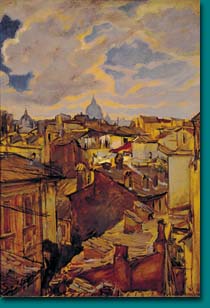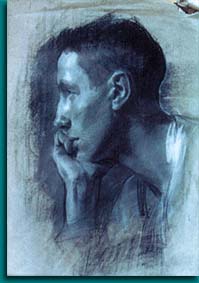 |
 |
 |
|
Light without Levity
In September 1922, at the behest of the local authorities, Fiore Brustolin held her first one-man show at Pieve di Cadore. Slim of build and distinctly pretty, the artist was still in her early twenties. The pictures she got ready for public appraisal had been painted that summer, while she was on vacation in the area.
Born at Piove di Sacco on 17 February 1901, Fiore showed remarkable artistic talent from an early age. By 1921 she had already passed her final exams at the Venice Fine Arts Academy with distinction, thus opening up the possibility of a teaching career. Ettore Tito considered her his most gifted pupil.
We have no detailed account of that first show at Pieve. What has come down to us, however, is a small exhibition poster painted by the artist herself. Significantly, it features an unfurled wing, ready for flight. At all events, the display of works certainly included various paintings and drawings, as well as a number of charming small landscapes that reflect the Cadore countryside of the time. Yet Fiore’s talent was particularly well suited to figure painting. In 1925 she completed a further course in painting at the Venice Academy, and the following year was able to open an atelier of her own in Venice. At the time it was unheard of for a woman to be teaching painting from her own studio.
It has always seemed curious that such a precocious talent somehow never achieved the renown it clearly deserved.
|
|


Roma. Il grande cupolone da Tor Millina - 1939
Olio su cartone - Roma, Collezione dell'artista

|
|
|


Ritratto di giovane pensieroso, 1924
pastello monocromo su carta
 |
|
The answer is simple enough, however. In 1929 Fiore got married, thereby adopting her husband Giorgio Zaccarian’s surname. The couple then moved, first to Genoa and then to Milan before settling in Rome in 1933. So her Venetian contemporaries literally lost sight of her. Had she not left her native city, along with Novati, Seibezzi, Mori, Dalla Zorza and Varagnolo she would no doubt have taken a leading role in the artistic circles that came to the fore around 1930. In Rome, on the other hand, though she continued to paint to considerable acclaim, her work remained distinctly Venetian in its fresh use of colour and was thus far removed from the dictates of the “Roman school” that held sway at the time.
True recognition came posthumously to Fiore Brustolin. After her death (6 August 1995) she was rediscovered and hailed as a wondrous surprise. Various exhibitions of her work were held, and Electa published an important monograph on her output. Now Pieve, the town that hosted her first public showing, has decided to devote another exhibition to her remarkable talent.
The show is divided into five sections housed in different venues. The splendid palace of the Magnifica Comunità houses her earliest work, including a number of paintings and drawings that must have been displayed in the 1922 exhibition. While flower paintings, still lifes and cityscapes are to be found in the Pieve Town Hall, the artist’s paintings of sacred subjects are exhibited in the house of Tiziano l’Oratore. The Sala Pubblica of neighbouring Tai di Cadore provides a fine setting for figure paintings and nudes, and the Museo dell’Occhiale (Spectacles Museum) gives visitors the chance to view a wide range of beautiful drawings, many of them on show for the first time.
Art is not exempt from fashion, and thus from idle chatter. Yet its intrinsic truth is revealed only to the eye, to first-hand visual experience. Thanks to the present exhibition, well over half a century of earnest artistic endeavour can finally speak for itself. As visitors will agree, the freshness of Fiore Brustolin Zaccarian’s artistic insight and talent shines untarnished through a turbulent age.
Paolo Rizzi
|
|
|
|
|
Fiore B. Zaccarian a Pieve di Cadore
|
|
 |
 |
|
 |
 |